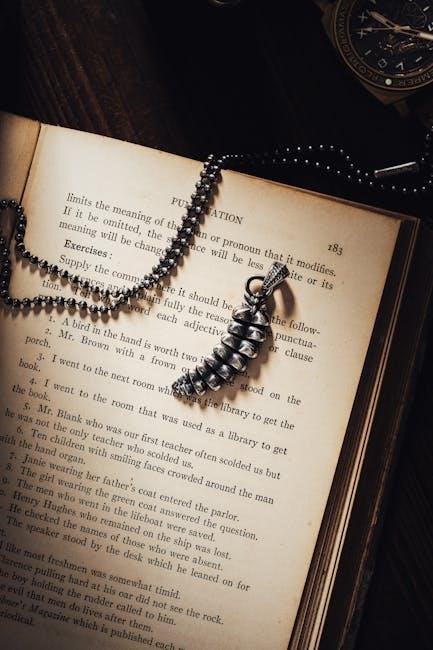Guy de Maupassant’s “The Necklace” is a timeless tale of greed‚ materialism‚ and fate‚ exploring themes that resonate universally. The story follows Madame Loisel‚ a woman consumed by her desire for wealth and status‚ leading to a tragic series of events. Maupassant’s masterful storytelling and the shocking twist at the end have made this short story a classic‚ offering profound lessons on the consequences of vanity and the importance of contentment. Its enduring relevance continues to captivate readers‚ making it a cornerstone of world literature.
Overview of the Story
“The Necklace” by Guy de Maupassant is a poignant tale of greed‚ sacrifice‚ and irony. Madame Loisel‚ a beautiful but discontented woman‚ borrows a diamond necklace for a party‚ only to lose it. Desperate to avoid shame‚ she and her husband replace it‚ leading to years of poverty. The story’s tragic twist reveals the necklace was fake‚ underscoring themes of materialism and the devastating consequences of vanity. Maupassant’s masterful storytelling leaves a lasting moral lesson.
Significance of the Title
The title “The Necklace” symbolizes the central conflict and themes of Guy de Maupassant’s story. It represents the elusive nature of wealth and status‚ as well as the deceptive appearances that drive human desire. The necklace embodies Madame Loisel’s longing for a life beyond her means‚ highlighting the destructive power of materialism. Its significance is amplified by the shocking twist‚ revealing it as a fake‚ thus underscoring the irony and moral lessons of the tale.

Plot Summary
Guy de Maupassant’s “The Necklace” recounts Mathilde Loisel’s tragic experience with a borrowed diamond necklace‚ exploring themes of greed‚ sacrifice‚ and the irony of fate.
The Setup: Madame Loisel and the Party Invitation
Madame Mathilde Loisel‚ a beautiful but discontented woman‚ borrows a diamond necklace from her wealthy friend Madame Forestier to attend a prestigious party. Her husband secures an invitation‚ but Mathilde feels out of place without luxurious attire; She covets the necklace to impress society‚ unaware of the tragic consequences this decision will bring. Her desire for status and luxury drives the story’s unfolding events.
The Loss of the Necklace
After a magical evening at the party‚ Madame Loisel discovers the necklace is missing. Frantic‚ she and her husband search but cannot find it. Desperate‚ they decide to replace it with a similar one‚ incurring massive debt. This act of desperation sets off a chain of sacrifices and hardships‚ altering their lives forever. The loss of the necklace becomes the catalyst for their downward spiral into poverty and regret.
The Resolution and Its Consequences
The Loisels spend years repaying the debt for the necklace‚ enduring immense hardship. After a decade‚ they finally pay it off‚ only to discover the necklace was a fake. This revelation underscores the tragedy of their sacrifices‚ leaving them with nothing but regret and a shattered life. The story’s poignant ending highlights the devastating consequences of their choices and the cruel irony of fate.

Themes Explored in the Story
Greed‚ materialism‚ and the pursuit of status drive the narrative‚ while sacrifice and the consequences of vanity are poignantly explored‚ revealing societal pressures and human frailty.
Greed and Materialism
Madame Loisel’s insatiable desire for wealth and luxury drives the story’s tragic events. Her dissatisfaction with her modest life leads her to borrow the necklace‚ symbolizing her obsession with status. The loss of the necklace plunges her into debt‚ highlighting the destructive nature of greed. Maupassant critiques societal pressures that equate worth with material possessions‚ illustrating how chasing wealth can lead to financial and emotional ruin‚ underscoring the futility of excessive ambition.
The Sacrifice and Its Impact
Madame Loisel’s decision to borrow the necklace leads to a decade of financial hardship and personal sacrifice. She and her husband dedicate years to repay the debt‚ losing their youth and comfort in the process. This sacrifice underscores the story’s moral‚ revealing how vanity and ambition can lead to long-term suffering. The necklace becomes a symbol of the devastating consequences of chasing status at the cost of true happiness.

Character Analysis
Madame Loisel’s desire for luxury drives her fate‚ while Madame Forestier’s kindness and wealth contrast her friend’s struggles‚ highlighting themes of vanity and socioeconomic disparity.
Madame Mathilde Loisel: Her Desires and Fate
Madame Mathilde Loisel‚ born into a humble family‚ yearns for a luxurious life. Her desire for wealth and status leads her to borrow a diamond necklace‚ symbolizing her aspirations. However‚ her fate takes a tragic turn when the necklace is lost‚ plunging her into years of debt and hardship. This relentless struggle ultimately reveals the devastating consequences of her vanity and unfulfilled desires‚ shaping her destiny forever.
Madame Forestier: The Owner of the Necklace
Madame Forestier‚ a wealthy friend of Madame Loisel‚ owns the exquisite diamond necklace. She lends it to Mathilde for a high-society ball‚ unaware of the impending tragedy. Her casual attitude toward the necklace contrasts with Mathilde’s obsession‚ highlighting the vast social divide between them. Forestier’s role is pivotal‚ as her necklace becomes the catalyst for Mathilde’s downfall‚ illustrating the superficiality of material wealth and the harsh realities of class differences in society.

The Twist Ending
The necklace Madame Loisel desperately replaces is revealed to be fake‚ leaving her and her husband in financial ruin for nothing‚ a poignant irony.
The Revelation About the Necklace
The shocking revelation occurs when Madame Loisel learns the necklace she borrowed was fake‚ rendering her years of financial sacrifice pointless. This twist underscores the irony of her plight‚ as the necklace’s value was imaginary‚ yet its impact on her life was devastatingly real. The discovery highlights Maupassant’s mastery of dramatic irony‚ leaving readers reflective on the consequences of illusion and deception.
Its Significance in the Story
The necklace symbolizes the elusive nature of wealth and status‚ driving Madame Loisel’s tragic pursuit of luxury. Its revelation as a fake highlights the irony of her sacrifices‚ emphasizing the theme of illusion versus reality. This twist profoundly underscores the story’s moral‚ cautioning against the destructive pursuit of materialism and the deceptive nature of appearances. It serves as a poignant reminder of life’s unpredictability and the consequences of human folly.
Moral and Lesson
The story teaches the dangers of vanity and greed‚ highlighting the importance of contentment. It warns against sacrificing happiness for material possessions‚ emphasizing true fulfillment lies within.
The Consequences of Vanity
Madame Loisel’s vanity leads to her ruin‚ as her desire for wealth and status results in financial ruin and years of hardship. Her quest for material possessions consumes her life‚ ultimately losing her youth and happiness. The story vividly illustrates how vanity can destroy one’s life‚ emphasizing the importance of self-acceptance and the fleeting nature of material wealth. It serves as a cautionary tale about the dangers of chasing superficial desires.
The Importance of Contentment
The story underscores the value of contentment through the contrast between Madame Loisel’s dissatisfaction and her husband’s acceptance of their modest life. Madame Loisel’s unhappiness stems from her desire for more‚ while Monsieur Loisel finds joy in simple pleasures. The narrative highlights how discontent can lead to ruin‚ while contentment fosters peace. This timeless lesson encourages readers to appreciate what they have‚ rather than endlessly chasing unattainable desires‚ ultimately promoting inner fulfillment and stability.

Historical Context
Written in the late 19th century‚ “The Necklace” reflects French society’s rising middle-class aspirations and materialism during the Third Republic. Maupassant’s critique of societal excesses resonates deeply‚ offering insight into the era’s class struggles and cultural values through his concise‚ impactful storytelling style.
The Time Period and Social Setting
“The Necklace” is set in late 19th-century France during the Third Republic‚ a period marked by rising middle-class aspirations and materialism. The story reflects societal pressures‚ as Madame Loisel‚ a clerk’s wife‚ yearns for luxury beyond her means. Maupassant critiques the era’s class struggles and the pursuit of status‚ highlighting the tension between modest living and the desire for upward mobility. This context underscores the story’s themes of ambition and societal expectations.
Maupassant’s Writing Style and Influence
Guy de Maupassant’s writing style in “The Necklace” is concise‚ realistic‚ and impactful‚ employing irony and a twist ending to convey moral lessons. His influence on literature is profound‚ as he pioneered the modern short story‚ inspiring writers with his ability to capture human nature and societal flaws. His work remains a benchmark for storytelling‚ blending simplicity with depth to create enduring tales that resonate across generations.
Symbols in the Story
The necklace symbolizes wealth and status‚ driving Madame Loisel’s obsession and the story’s tragic events‚ while the party represents fleeting joy‚ highlighting the emptiness of material pursuits.
The Necklace as a Symbol of Wealth and Status
The necklace in Maupassant’s story is a potent symbol of wealth and status‚ embodying Madame Loisel’s aspirations and societal pressures. Its allure drives her to borrow it‚ believing it will elevate her standing. The necklace represents the unattainable luxury she craves‚ highlighting the class divide and her inner discontent. Its loss triggers a chain of events‚ underscoring the destructive power of materialism and the pursuit of status.
The Party as a Symbol of Temporary Happiness
The party represents a fleeting moment of joy and prestige for Madame Loisel‚ offering her a temporary escape from her mundane life. It symbolizes the illusion of happiness derived from social status and material possessions. The luxury and admiration she experiences are short-lived‚ however‚ as the loss of the necklace shatters her illusion‚ leading to years of suffering. The party serves as a catalyst for her tragic downfall‚ highlighting the emptiness of superficial happiness.

Reception and Popularity
Guy de Maupassant’s “The Necklace” remains a beloved classic‚ celebrated for its timeless themes and masterful storytelling. Its enduring popularity lies in its universal appeal‚ resonating with readers across generations and cultures. The story’s powerful message and unexpected twist have solidified its place as one of the most influential works in world literature‚ continuing to captivate audiences today.
Why “The Necklace” Remains a Classic
Guy de Maupassant’s “The Necklace” endures as a timeless classic due to its universal themes of greed‚ vanity‚ and the consequences of desire. Its masterful storytelling‚ coupled with a shocking twist‚ captivates readers. The story’s concise yet profound exploration of human nature resonates across cultures and generations. Maupassant’s ability to weave a tale of tragedy and irony ensures its relevance‚ making it a cornerstone of world literature and a must-read for audiences worldwide.
Its Impact on Literature and Readers
“The Necklace” has profoundly influenced literature‚ setting a benchmark for short story writing. Its exploration of human flaws and societal pressures resonates deeply‚ making it a favorite in classrooms and among readers. The story’s timeless themes of greed‚ vanity‚ and consequence continue to inspire writers and captivate audiences‚ ensuring its lasting impact on both literature and readers worldwide for generations.
Comparison with Other Works
Maupassant’s “The Necklace” differs from his other works like “Two Friends‚” which focuses on friendship during war‚ showcasing his versatility in exploring greed versus camaraderie through distinct narratives.
Similar Themes in Maupassant’s Other Stories
Maupassant’s works often explore themes of greed‚ sacrifice‚ and the consequences of human folly. In “Two Friends‚” he examines loyalty and fate during wartime‚ while in “The Necklace‚” materialism drives the plot. Both stories use irony and tragic endings to highlight societal flaws. Maupassant’s ability to weave universal themes into relatable scenarios solidifies his reputation as a master of short story writing‚ consistently drawing readers into moral dilemmas and emotional depths.
Differences in Narrative Approach
Much like “The Necklace‚” Maupassant’s other stories feature concise‚ impactful narratives‚ but their approaches vary. While “The Necklace” relies on a twist ending‚ “Two Friends” focuses on introspective dialogue and wartime drama. Maupassant experiments with tone‚ shifting from the tragic irony of “The Necklace” to the somber realism of “Boule de Suif.” This versatility in narrative style highlights his mastery of diverse storytelling techniques while maintaining his signature insight into human nature and societal flaws.
Guy de Maupassant’s “The Necklace” delivers a poignant lesson on the dangers of vanity and the transformative power of sacrifice. Its enduring relevance lies in its universal themes‚ making it a timeless literary masterpiece that continues to resonate with readers today.
Final Thoughts on the Story
“The Necklace” by Guy de Maupassant is a masterful tale of greed‚ sacrifice‚ and the consequences of vanity. Madame Loisel’s journey from envy to despair underscores the destructive nature of materialism. The story’s twist ending leaves a lasting impact‚ reminding readers of the unpredictability of life and the importance of appreciating one’s circumstances. Maupassant’s vivid characters and moral lessons ensure the story’s timeless appeal‚ making it a memorable and thought-provoking read.
Its Relevance in Modern Times
“The Necklace” remains strikingly relevant today‚ as its themes of materialism and vanity continue to resonate. In an age dominated by social media‚ where appearances and status are often obsessively curated‚ Maupassant’s critique of societal pressures feels as poignant as ever. The story serves as a timeless cautionary tale‚ urging readers to reflect on their values and find contentment in simplicity‚ making it a universally important narrative even in modern times.
